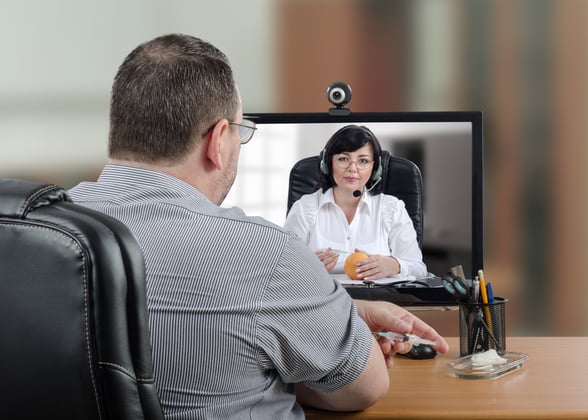Everything is high-tech in 2015, and that includes how many visit the doctor, through the latest telemedicine technology. Think of it as "digital house calls" by doctors.
The UMHS Endeavour looks at why telemedicine is growing, the many advantages, from helping patients to financial savings, plus the latest technology in telemedicine and how it all benefits both patients and future doctors at American and Caribbean medical schools.
We will summarize recent online news reports on the telemedicine trend and why it is improving patient care and cost savings in the health care community.
The Demand for Telemedicine
Telemedicine is a virtual visit to the doctor or, as GlobalMed.com explains, “medicine delivered from a distance.” For example, a homebound elderly patient has a rash on her arm she wants looked at, or another in a rural area has mild flu-like symptoms. Just a few years ago, patients like this would have to travel to the doctor, and many might not seek care because the person either could not get to a nearby doctor or it was deemed inconvenient. With telemedicine, however, more people are able to get the health care they need, and many major insurance companies will cover the cost like a traditional doctor visit.
In a January 13, 2015 article, “Why Telemedicine’s Time Has Come,” Skip Fleshman wrote on Forbes.com that “telemedicine may just be the biggest trend in digital health in 2015”.
Mr. Fleshman quoted Andrew Watson, Chief Medical Director of Telemedicine at University of Pittsburgh Medical Center, “Telemedicine is moving like lightning. We’re able to do so much more than before,” noting that faster internet connections and more high-tech software have made the practice easier.
Mr. Fleshman said that the popularity of smartphones and tablets allows people to access health care from virtually anywhere, and the burgeoning phenomenon of electronic health records “has certainly increased the ease of going digital.”
The website GlobalHealthIT wrote in in a January 14, 2015 article about the main reasons telemedicine is growing so fast. They noted how Internet connections and software and the popularity of mobile devices are helping to make telemedicine more efficient.
“Patients are comfortable with asynchronous messaging, which can be more time-efficient for doctors,” GlobalHealthIT also said.
The Financial Benefits of Telemedicine
Telemedicine saves money, experts say. Paying for telemedicine has become easier thanks to new legislation that GlobalHealthIt said “has extended reimbursement to veterans and Medicare patients,” adding that New York has become the 22nd state “to require parity in reimbursement for telehealth visits.."
Global HealthIt said that investors “pumped a record $6.5 billion into digital health ventures during 2014, an increase of 125 percent from the 2013 level, StartUp Health reported recently.”
Short Facts About Telemedicine
As the website for the American Telemedicine Association (www.americantelemed.org/) explains, “Telemedicine is the use of medical information exchanged from one site to another via electronic communications to improve a patient’s clinical health status. Telemedicine includes a growing variety of applications and services using two-way video, email, smart phones, wireless tools and other forms of telecommunications technology.”
Following are short facts about telemedicine from the American Telemedicine Association:
- Telemedicine is not a separate medical specialty.
- Products and services related to telemedicine are often part of a larger investment by health care institutions in either information technology or the delivery of clinical care.
- Even in the reimbursement fee structure, there is usually no distinction made between services provided on site and those provided through telemedicine and often no separate coding required for billing of remote services
Help for Elderly Patients
As we noted earlier, telemedicine is a great solution for patients that can’t get to the doctor. Mr. Fleshman discussed this notion in detail in his Forbes.com article. He quoted Dr. Steve Ommen, Associate Dean at the Center for Connected Care at the Mayo Clinic, on why telemedicine is so beneficial to seniors.
“The fastest-growing demographic for social media is the 60+ group,” Dr. Ommen told Forbes. “They are not technology-averse and they have the greatest mobility challenge in terms of getting to a doctor. A telemedicine solution may be exactly what they need.”
Dr. Ommen explained to Forbes how telemedicine saves both time and money. ““Doctors right now spend a lot of time with patients who don’t need to be in the office,” he said. “If we can change the way they interact with people who don’t need to be in the room, we can improve access for people who do.”
New Telemedicine Technology
Telemedicine can be used in such specialties as primary care, audiology, dermatology, pediatrics, pulmonology, cardiology, OB/GYN and more. Companies such as GlobalMed have products such as Clinical Access Stations, offering cameras and monitors that help physicians diagnose and treat patients from a distance.
GlobalMed is not the only firm with high-tech telemedicine products. The infographic below from Aranca says the Top 5 companies offering telemedicine products in the USA include AmericanWell, MD Live, Teladoc, SoloHealth, and Healthspot.
(Top photo) TELEMEDICINE MAKES DIGITAL HOUSE CALLS: Brings health care to people in medically underserved areas, such as rural communities. Photo: Deposit Photo.
About UMHS:
Built in the tradition of the best US universities, the University of Medicine and Health Sciencesfocuses on individual student attention, maintaining small class sizes and recruiting high-quality faculty. We call this unique approach, “personalized medical education,” and it’s what has led to our unprecedented 96% student retention rate, and outstanding residency placements across the US and Canada. UMHS is challenging everything you thought you knew about Caribbean medical schools.

Scott is Director of Digital Content & Alumni Communications Liaison at UMHS and editor of the UMHS Endeavour blog. When he's not writing about UMHS students, faculty, events, public health, alumni and UMHS research, he writes and edits Broadway theater reviews for a website he publishes in New York City, StageZine.com.
















